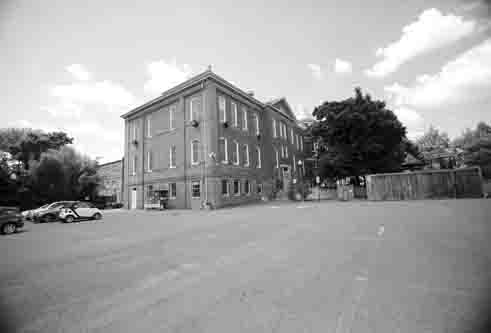Neighbors Wary of Density in Fillmore Redevelopment

By Brady HoltCurrent Staff Writer
A pair of informal development proposals hint at the possible future of Georgetown’s Fillmore School property, a 1.2-acre site at 1801 35th St. that’s currently listed for $14 million.
Both envision new row houses along 34th Street — replacing most of a surface parking lot — along with residential apartments in the 1893 Fillmore building. And both have sparked concerns about density, traffic, aesthetics and other issues.
The property is for sale by George Washington University, which acquired the building and land when it absorbed the Corcoran College of Art + Design. Proceeds from the sale will help fund renovations of the main Corcoran building at 17th Street and New York Avenue NW. The university has said it expects prospective buyers to include schools and other institutions, as well as developers.
Two companies submitted concept plans for review by the Georgetown advisory neighborhood commission and the Old Georgetown Board, but they were withdrawn from consideration at the university’s request.
At their meeting on Monday, neighborhood commissioners instead adopted a set of “community expectations” that they hope the university will show to prospective buyers.
“Bidders should be well aware of what is likely to be welcomed by the community and what is likely to infringe on the community’s view of what should be there — and the consequences that could flow from that,” commission chair Ron Lewis said at the meeting.
Neither of the concepts submitted by developers met all of the commission’s criteria, which call for:■ the preservation of “most” current open space, including on 35th Street;■ a maximum of 10 units in the Fillmore building;■ no expansion or major aesthetic changes to the Fillmore building;■ any new 34th Street row houses (of which there could be “several”) to match the two-story height, massing and setbacks of nearby homes;■ a prohibition on residents receiving residential parking permits;■ access from a 34th Street driveway at the north side of the property rather than a narrow public alley to the south; and■ the preservation of a 35th Street “tot lot” playground.
Lewis said he wished the university were working proactively with the community. In a statement to The Current, spokesperson Candace Smith wrote that the school must focus on raising money for the Corcoran’s 17th Street building.
“The university took on the responsibility for the renovation with the understanding that the proceeds from the Fillmore sale would be available to partly fund this renovation effort,” wrote Smith. “GW has a strong interest in the Fillmore sale helping to meet significant funding needs.”
The two proposals were provided to The Current by community members. The first, prepared by the Georgetown firm Overmyer Architects for an unidentified client, includes 14 condo units in the Fillmore building and nine three-story row houses (seven on 34th Street and two on 35th Street), with parking and a 10th single-family home in the middle of the property. The plan would relocate the 35th Street tot lot but retain its size. Access would be from the existing driveway on the north side and the southern alley.
The second, prepared by architecture firm Antunovich Associates, is slightly more modest but still denser than the neighborhood commission is envisioning. Six three-story row houses would line 34th Street; 12 units would go into the Fillmore building; the existing tot lot and adjacent open space would remain; and all access would be from a widened 34th Street driveway on the north side.
A number of neighbors who had seen the Overmyer concept spoke out against the proposals.
“That land is going to be built [on] — it’s just a given — but the density is a concern and the egress is going to be a concern,” said 34th Street resident Kathy Thompson.
Greg Kaufman, another 34th Street neighbor, alluded to Sachiko Kuno and Ryuji Ueno, who own two prominent Georgetown estates.
“We would love it if a school would buy it, we would love it if that nice Japanese couple would add it to their portfolio, but we recognize they might not do that and it’s going to be developed,” Kaufman said. “But these are our concerns and we’re very serious about it.”
George Washington University has said it expects to begin reviewing purchase offers in April. The neighborhood commission and Old Georgetown Board will review the design of any proposal once the purchase goes through. Furthermore, converting the Fillmore building into apartments would require approval by city zoning authorities.
Fillmore was an elementary school serving Georgetown and Burleith from 1893 to 1974, when it became the Fillmore Arts Center — dedicated art space for children at various nearby public schools.
That program moved next door to Hardy Middle School’s building in 1998, at which point the city sold the Fillmore building to Corcoran. Corcoran students will use the building through the current semester before relocating to other George Washington University sites.
A previous development plan from firm EastBanc — which also envisioned condos and town houses — was scrapped about five years ago amid community opposition.
This article appears in the March 4 issue of The Georgetown Current newspaper.
